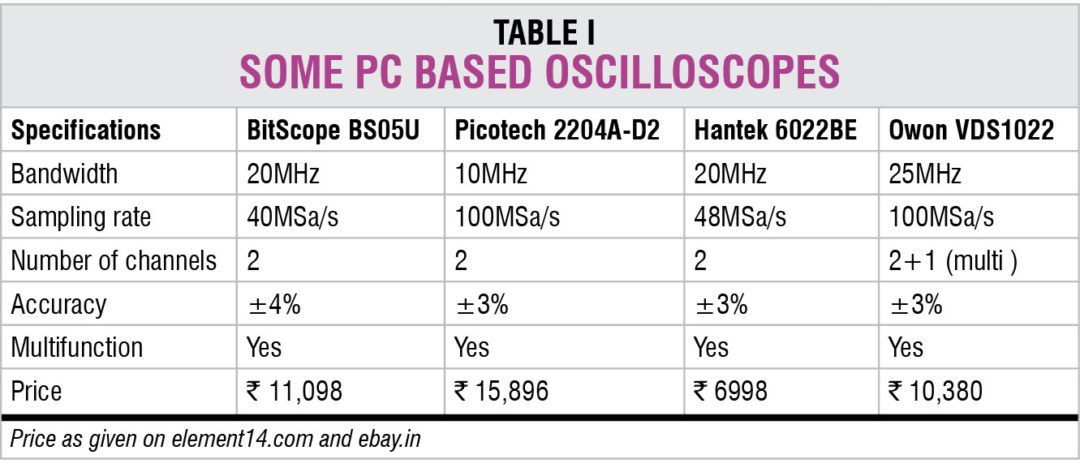External trigger. This is not used often but is sometimes very useful. The trigger controls let you stabilise repeating waveforms and capture single-shot waveforms. The trigger makes repeating waveforms appear static on the oscilloscope display.
Display size. Display size always matters as we see signal waveforms on the oscilloscope’s screen. A bigger screen display is always more comfortable to watch and work with. There are traditional cathode ray tubes, thin-film-transistor liquid-crystal displays with touchscreen display, flexible display and so on.
Form factor. Oscilloscopes may be divided into three categories depending on size and shape: benchtop, handheld and PC based.
A benchtop oscilloscope is aimed at having the highest performance. Almost all functionalities are available in this category. Handheld is portable and hence advantageous for the user on the move, but display quality and performance may be poor as compared to benchtop.
A PC based oscilloscope is becoming popular because PCs and laptops are easily available at home or workplace. You just need a portable external hardware or a dedicated add-on card in your PC along with suitable software.
Wireless supported. Wireless oscilloscopes support Bluetooth and Wi-Fi interface. The oscilloscope uses Wi-Fi module to create its own WLAN hotspot. Measurements can be done using the Web browser on a notebook, tablet or mobile phone.
With wireless, the PC becomes a virtual oscilloscope and can be used in special situations such as monitoring the signal while on the move or life-risky environment like in nuclear stations. But most wireless oscilloscopes have limited bandwidth.
IoT supported. Scopes having built-in wireless LAN module or Wi-Fi module act as hotspots. Some oscilloscopes have dedicated Ethernet ports for connecting to the Internet. Measurements can be monitored remotely using the Web browser on tablets, smartphones or PCs. The Internet of Things (IoT) capability on the scope allows measurements on high-voltage environments and brings safety to users.
Industrial automation, education management, remote test and measurement and some other functions need IoT oscilloscopes.
Technical specifications of some budget-friendly oscilloscopes are listed in Table II.
New trends in Oscilloscopes
In recent years, we have seen many changes in budget-friendly oscilloscopes. We see many innovations with added features in today’s oscilloscope like better performances including higher capture rate and CPU performance, features such as smart trigger and decoding, and mixed-signal oscilloscopes and arbitrary waveform generators.

Technological advancement in analogue-to-digital converters has resulted in high vertical resolution scopes that give better measurement accuracy.
Apart from wireless and IoT features, the latest scopes are enhanced with logic analysers, spectrum analysers, digital voltmeters, protocol analysers, counters and so on.
In the future we could see smarter and virtual oscilloscopes with even more features at much lower cost.
To conclude, if you are planning to buy a budget-friendly oscilloscope, first check your requirement, search the Internet for options and see if you can find a value-for-money oscilloscope. But keep in mind that you should never compromise on bandwidth, signal capture rate and display.
Explore our other technical buyer’s guides
Sani Theo is senior assistant editor – tech at EFY











I very recently purchased a DS203, (also referred to as a DSO203 or DSO Quad), Analog/Digital scope for hobby-experimental use. I’m new to scopes, so I expected some degree of a learning curve.
First, it is a very nice looking device and comes with some connectors and a carry bag.
Second, this scope comes with absolutely no printed documentation. Instead, it comes with a mini-CD which contains several folders which contain various files, but, no clear instructions as to how to operate the device or simple analog examples, such as testing an analog signal.
You are given a very brief, difficult to understand instruction about loading the operating system from the disc and a link for more recent updates.
Apparently, it is quite easy to “brick”, (crash, make unusable), the device during the software update process, because much of the discussion on the forum at the provided link concerns that topic.
It appears that this device is entirely user supported with no real instructions, tutorials or documentation from the manufacturer.
I’ve spent several hours trying to figure out this device and I’m still at square one !
I can’t seem to get it to display a simple audio signal I provide it. It leaves me wondering if it’s Me, if its really that hard, or if its just broken…
I googled DS203 to see what I could find, in the way of instruction or help, but, there isn’t much of anything.
There is one app, written by a user, that looks like it is supposed to take an audio input and display it, but, it doesn’t seem to work, at all.
There is a calibration function, but, I can’t figure out how it works. There are no hints.
For a beginner, this scope is not for you.
If you have one of these scopes and have figured out how to use it, I’d like to hear from you, as I’m at the point where I’m ready to send this thing back and buy a “Real” analog scope.
How to find prices of product and contact of seller